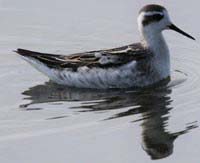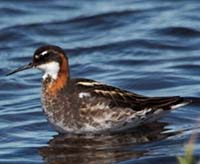Red-necked Phalarope
Scientific name: Phalaropus lobatus


Cover photo credit: © Quinten Wiegersma CC BY-NC (left) and Timothy Haan (right)
Status
Special concern
"Special concern" means the species lives in the wild in Ontario, is not endangered or threatened, but may become threatened or endangered due to a combination of biological characteristics and identified threats.
Date added to the Species at Risk in Ontario List
June 15, 2016
Read the assessment report (PDF)
What it looks like
The Red-necked Phalarope is a small shorebird with a long thin beak. It has a blue-grey body with tan wing stripes, a red-orange neck and dark head. Females are slightly larger and brighter than the males. During the winter, it moults to a grey-white body with dark sides of the head and crown.
Where it lives
It lives in coastal and inland marshes where it feeds in shallow ponds and nests on the grassy edges. It avoids mud and dense shrubs. Nests are located on the ground in dense grasses and sedges. During migration and in the winter, the Red-necked Phalarope is always near water, either saltwater, or freshwater ponds, lakes, ditches or lagoons.
Where it’s been found in Ontario
The Red-necked Phalarope breeds on Hudson Bay and James Bay in the summer but during spring and fall migration may occasionally be observed in the rest of Ontario. It is most abundant in summer in Polar Bear Provincial Park. In the fall it migrates out of the province to overwinter offshore in the Pacific Ocean from Panama to Peru. Little is known about its migration routes.
What threatens it
Some of its breeding habitat along Hudson Bay and James Bay is being degraded by the feeding activity of expanding colonies of Snow Geese. Their grubbing and grazing creates mud flats out of the marsh. An additional threat is posed by climate change which may reduce the amount of grass-sedge wetlands used for breeding.
Action we are taking
Special concern species do not receive species or habitat protection.
What you can do
Report a sighting
The Ministry of Natural Resources and Forestry tracks species at risk such as the Red-necked Phalarope. You can use a handy online form to report your sightings to the Natural Heritage Information Centre. Photographs with specific locations or mapping coordinates are always helpful.
Volunteer
Volunteer with your local nature club or provincial park to participate in surveys or stewardship work focused on species at risk.
Be a good steward
- Private landowners have a very important role to play in species recovery. You may be eligible for stewardship programs that support the protection and recovery of species at risk and their habitats.
- Bird Studies Canada is working to advance the understanding, appreciation and conservation of wild birds and their habitat in Ontario and elsewhere. For more information on how you can help.
- The Canada-Ontario Farm Stewardship Program is available to farmers registered under the Canada-Ontario Environmental Farm Plan to encourage greater protection and conservation of habitat for species at risk.
- As with all wildlife, don’t disturb or harass birds or nesting sites. Be respectful and observe from a distance.
Report illegal activity
Report any illegal activity related to plants and wildlife to
Quick facts
- Male Red-necked Phalaropes incubate the eggs and care for the young without the help of the female.
- This phalarope spends much of its life at sea; it is not known if the same ones that stage in the Bay of Fundy on the Atlantic Ocean migrate to the Pacific Ocean off Central and South America.
- During the winter, Red-necked Phalaropes concentrate on the ocean in areas where upwellings force their food, shrimp and other invertebrates to the surface.
- Phalaropes spin circles in the water using their feet and legs, and form a vortex to drive plankton and small aquatic invertebrates up to the surface for them to feed on.